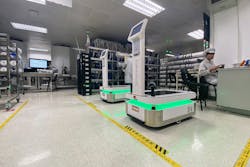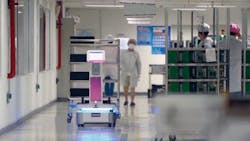Over the past several years, autonomous mobile robots (AMRs) have proven themselves a force to be reckoned with in the material handling space. Serving as a viable replacement for both stationary conveyor belts and automated guided vehicles (AGVs) that require permanent wire strips or magnetic tracks be placed along the floor to guide their path, AMRs offer a degree of flexibility that was previously impossible.
Moreover, like other non-fixed technologies such as wearables, 5G is giving AMR deployment a boost. 5G can allow AMRs to utilize navigation algorithms and virtual map sharing to coordinate their activities with one another and optimize workflows. In many cases, previous wireless connectivity has not been able to provide the seamless coverage and high data transfer speeds necessary to facilitate this level of bandwidth or reliability.
Electronics company TCL’s manufacturing facility in Huizhou, China is a prime example of a plant that has taken advantage of 5G’s capabilities to expand its usage of AMRs. The company has installed dozens of ForwardX Max 300 Lift AMRs, which communicate through a 5G network established as part of TCL’s 5G+ Smart Factory Initiative, to automate material handling tasks throughout its production facility.
The AMRs have yielded efficiency gains for TCL’s manufacturing operations by allowing the movement of materials throughout its plant to be carried out with more speed and consistency. Flexibility has also been been increased, as facility managers can now more easily make alterations to production processes that occur seasonally or in response to fluctuating demand. In addition, the AMRs have rendered TCL less vulnerable to shifting trends in wage and labor availability by reducing reliance on human workers for rote and repetitive tasks such as material handling.Plant safety was also a concern that was surmounted with the help of ForwardX’s AMRs. Often, plants and warehouses looking to increase their material handling capacity amid rising consumer expectations increase their reliance on forklifts, despite the fact that 11% of all forklifts are involved in an injury each year. By contrast, AMRs, which offer 360-degree obstacle detection and avoidance through light detection and ranging (LiDAR) technology, entail substantially less risk.
“When considering solutions, safety is an important factor for us, because our production lines consist of a lot of machines and our environment is highly dynamic with a lot of moving pieces, such as material carts,” said Zhengwei Cai, project manager and senior engineer in TCL’s Huizhou facility. “Therefore, obstacle avoidance and safety functions are very important to us. With ForwardX, the AMRs calculate optimal routes and automatically detect, identify, and avoid collisions with any kind of obstacle.”
So far, TCL reports that the adoption of AMRs has improved productivity across various production processes, reduced labor dependency, and yielded quicker inventory turnover. 34 workers ranging from planners and dispatchers to front-line managers have been repurposed to engage in higher-level tasks, and the company predicts that a full return-on-investment (ROI) will be achieved within three years. Going forward, the company is evaluating the use of more AMRs for intralogistics workflows such as raw material delivery, work-in-process transfer, and finished goods storage across its other production locations.
About the Author
David Miller
Former Senior Technical Writer

Leaders relevant to this article:

